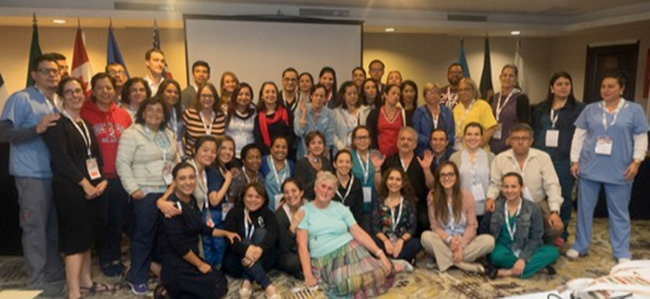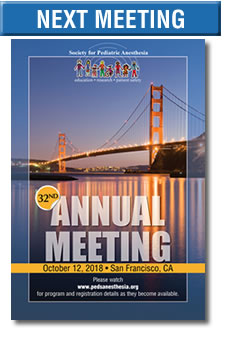The Safe PAEDS Experience
The Safe PAEDS Experience in Latin America
By Andrea Gomez Morad, MD and Pilar Castro, MD, MSEd
The SAFE (Safer Anesthesia From Education) Paediatric anesthesia course – SAFE Paeds – is a refresher course created as an international educational initiative by the Association of Anaesthetists of Great Britain and Ireland (AAGBI) in partnership with the World Federation of Societies of Anaesthesiologists (WFSA) in 2014. It was a response by these two institutions to the need for pediatric-specific anesthetic training in Low- and Middle-Income Countries (LMICs).
In the Spring 2018 issue of SPAnews, Dr. Choi and Dr. Evans described the history of the SAFE Paeds course and how the content of the course and training has been adapted to different LMICs in Asia and Africa. In their report, Dr. Choi and Dr. Evans highlighted the importance of developing sustainable efforts that emphasize patient safety and outcomes, with a long-term focus on reducing the need for external support.
As a next step, it seemed only natural to expand the SAFE Paeds initiative to Latin America. With the support of SPA, WFSA, and the Guatemalan Society of Anesthesia, a SAFE Paeds course was conducted in Guatemala City, Guatemala, from November 30th to December 3rd, 2017. Herein, we tell the story from our perspective as pediatric anesthesiologists who trained and practice in the United States, but who grew up Latin America.
Latin America and the Caribbean is a large and diverse region, comprised of 20 countries that occupy 13% of the planet’s land surface, or 7,775,857 square miles. Latin America is one of the most urbanized regions in the world, where 80% of its 650 million inhabitants live in metropolitan areas. Latin Americans are also a young people: 26% are under the age of 16 (1).
There are large imbalances in distribution of healthcare resources in Latin America and the Caribbean. According to a WFSA workforce survey published in 2017, the number of anesthesia providers in the region ranges from 19.2/100,000 people in Bolivia, to 1.7/100,000 in Peru, to as low as 0.8/100,000 in Haiti. In contrast to sub-Saharan Africa, most anesthesia providers in Latin American and the Caribbean are physicians. However, anesthesiologists in Latin America are concentrated in urban areas. Thus, access to high quality and safe anesthesia services in rural areas is scarce. Perioperative child mortality in the region increased over the past decade, especially in less developed countries like Bolivia, Nicaragua and Honduras (10.7-15.9 deaths per 10,000 anesthetics). Mortality rates vary greatly, even in more developed countries like Brazil (9.8 per 10,000 anesthetics), or Chile and Argentina (0.41-6.8 per 10,000 anesthetics).
Dr. Faye Evans, current chair of the SPA Committee on International Education & Service has been intimately involved with SAFE Paeds since its development. She easily sold the idea of organizing a SAFE Paeds course for Latin America to us, two Spanish-speaking pediatric anesthesiologists with an interest in education and global health. The rest of the faculty included volunteers from the United States, Canada, Mexico, Guatemala, Honduras, and Chile. Our first task was to translate the faculty and participant’s manual into Spanish. We were conscious that a Latin American SAFE Paeds course offered a unique challenge. The course had to be geared toward a different audience than previous courses: mostly physicians already trained in anesthesiology, and some of them even with formal training in pediatric anesthesia.
There were 34 participants, selected by their respective national anesthesia societies to participate in the SAFE Paeds course and to lead future SAFE Paeds courses in Latin America. Therefore, an additional half day train-the-trainer session complemented the 3-day course. Each day consisted of a series of short interactive lectures followed by small group discussions and low-fidelity simulation scenarios. These sessions quickly revealed the diverse background of the participants. Some worked in institutions and health care systems with ample resources and state-of-the-art equipment, while others constantly lacked even basic medications and had very meager resources. What they had in common was the eagerness to improve their knowledge base in anesthesia and deliver excellent care to their patients.
In our daily debriefings, we realized how much we were all learning. Both faculty and participants attained their goals to acquire knowledge, skills and tools to teach how to provide safe anesthesia to children. This model spoke to our hearts, and we feel that these wonderful anesthesiologists are now empowered to be agents of change in their institutions and countries.

Participants and faculty of the first SAFE Paeds course in Latin America. November 30th-December 3rd 2017; Guatemala City, Guatemala
References
- 2017 Population Reference Bureau. http://www.prb.org
- Carpio Carmen and Natalia Santiago Bench. 2015. The health workforce in Latin America and the Caribbean: An Analysis of Colombia, Costa Rica, Jamaica, Peru and Uruguay. Directions in Development. Washington, DC: World Bank. Doi: 10.1596/978-1-4648-0594-3. License: Creative Commons Attribution CC BY 3.0 IGO.
- Braz LG, Módolo NS, do Nascimento P Jr, et al. Periopera- tive cardiac arrest: a study of 53,718 anesthetics over 9 yr from a Brazilian teaching hospital. Br J Anaesth. 2006; 96(5): 569-575.
- WFSA Fellowship training programs. Available in: http://www.wfsahq.org/training- programs/50-wfsa-fellowship-training-programs






